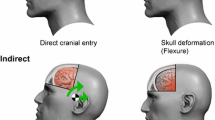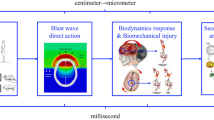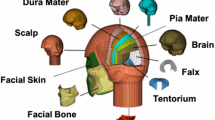Abstract
Primary blast wave impact on military personnel is of major concern, particularly as it relates to traumatic brain injury. To gain insights into the brain’s response to primary blast impact, the current research employed a surrogate head form filled with biogel brain simulant and subjected it to primary blast waves propagating 180 mm from a 1.7-g cyclotrimethylene trinitramine Class 5 (RDX) explosive charge. The blast impacts to the surrogate head were investigated using combined approach of experiments and computations. More specifically, the combination of (1) high-speed imaging techniques, (2) embedded intracranial pressure sensors, and (3) numerical simulation techniques was used to study the blast wave/head interactions in terms of the external impact loading, intracranial pressures, and deviatoric stresses. The experimental and computational results show that the intracranial wave generated in the surrogate brain was a consequence of blast interactions with the surrogate skull. The resulting intracranial pressures were shown to be within threshold limits that could induce minor or mild traumatic brain injuries. Strong oscillations between compression and volumetric tensions were pronounced in the anterior region of the surrogate brain following frontal blast impact. Focal regions of elevated stress were captured in the simulation at the posterior region of the surrogate brain resulting from multiple reflections off the back of the skull. Deviatoric stress distributions were also revealed at the skull/surrogate brain interface where more dominant forces appeared at the base (interface) of the skull. These results indicate the potential for shearing/tearing of brain tissue material due to blast loading.
















Similar content being viewed by others
References
Defense and Veterans Brain Injury Center. DOD TBI Worldwide Numbers. https://health.mil/About-MHS/OASDHA/Defense-Health-Agency/Research-and-Development/Traumatic-Brain-Injury-Center-of-Excellence/DOD-TBI-Worldwide-Numbers
Panzer, M., Bass, C., Rafaels, K., Shridharani, J., Capehart, B.: Primary blast survival and injury risk assessment for repeated blast exposure. J. Trauma Acute Care Surg. 72(2), 454–466 (2012). https://doi.org/10.1097/ta.0b013e31821e8270
Kinney, G., Graham, K.: Explosive Shocks in Air. Springer, New York (1985)
Cooper, P.W.: Explosives Engineering. Wiley-VCH, New York (1997)
Moore, D.F., Jaffe, M.S.: Military traumatic brain injury and blast. NeuroRehabilitation 26(3), 179–181 (2010). https://doi.org/10.3233/NRE-2010-0553
Taylor, P.A., Ford, C.C.: Simulation of blast-induced early-time intracranial wave physics leading to traumatic brain injury. J. Biomech. Eng. 131(6), 61007 (2009). https://doi.org/10.1115/1.3118765
Warden, D.L., French, L.M., Shupenko, L., Fargus, J., Reidy, G., Erickson, M.E., Jafee, M.S., Moore, D.F.: Case report of a soldier with primary blast brain injury. Neuroimage 47, T152–T153 (2009). https://doi.org/10.1016/j.neuroimage.2009.01.060
Banton, R., Piehler, T., Zander, N., Benjamin, R., Duckworth, J.: Comparison of numerical simulations with experiments of blast-induced pressure wave impact on a surrogate head model. In: Kimberley, J., Lamberson, L., Mates, S. (eds.) Dynamic Behavior of Materials, Volume 1, Conference Proceedings of the Society for Experimental Mechanics Series, pp. 181–187. Springer Nature, Cham (2018) https://doi.org/10.1007/978-3-319-62956-8_30
Bauman, R.A., Ling, G., Tong, L., Januszkiewicz, A., Agoston, D.: An introductory characterization of a combat-casualty-care relevant swine model of closed head injury resulting from exposure to explosive blast. J Neurotrauma. 26(6), 841–860 (2009). https://doi.org/10.1089/neu.2008.0898
Cernak, I., Merkle, A.C., Kiolatsos, V.E., Bilik, J.M., Luong, Q.T., Mahota, T.M., Xu, L., Slack, N., Windle, D., Ahmed, F.: The pathobiology of blast injuries and blast-induced neurotrauma as identified using a new experimental model of injury in mice. Neurobiol. Dis. 41, 538–551 (2011). https://doi.org/10.1016/j.nbd.2010.10.025
Chavko, M., Koller, W.A., Prusaczyk, W.K., McCarron, R.M.: Measurement of blast wave by a miniature fiber optic pressure transducer in the rat brain. J. Neurosci. Methods 159(2), 277–281 (2007). https://doi.org/10.1016/j.jneumeth.2006.07.018
Sosa, M.A., De Gasperi, R., Paulino, A.J., Pricop, P.E., Shaughness, M.C., Maudlin-Jeronimo, E., Hall, A.A., Janssen, W.G., Yuk, F.J., Dorr, N.P., Dickstein, D.L., McCarron, R.M., Chavko, M., Hof, P.R., Ahlers, S.T., Elder, G.A.: Blast overpressure induces shear-related injuries in the brain of rats exposed to a mild traumatic brain injury. Acta Neuropathol. Commun. 1, 51 (2013). https://doi.org/10.1186/2051-5960-1-51
Long, J.B., Bentley, T.L., Wessner, K.A., Cerone, C., Sweeney, S., Bauman, R.A.: Blast overpressure in rats: recreating a battlefield injury in the laboratory. J. Neurotrama 26, 827–840 (2009). https://doi.org/10.1089/neu.2008.0748
Alley, M.D., Schimizze, B.R., Son, S.F.: Experimental modeling of explosive blast-related traumatic brain injuries. Neuroimage 54, S45–S54 (2011). https://doi.org/10.1016/j.neuroimage.2010.05.030
Hua, Y., Akula, P.K., Gu, L., Berg, J., Nelson, C.A.: Experimental and numerical investigation of the mechanism of blast wave transmission through a surrogate head. J. Comput. Nonlinear Dyn. 9(3), 31010 (2014). https://doi.org/10.1115/1.4026156
Zhu, F., Wagner, C., Dal Cengio Leonardi, A., Jin, X., Vandevord, P., Chou, C., Yang, K.H., King, A.I.: Using a gel/plastic surrogate to study the biomechanical response of the head under air shock loading: a combined experimental and numerical investigation. Biomech. Model. Mechanobiol. 11(3–4), 341–353 (2012). https://doi.org/10.1007/s10237-011-0314-2
Moore, D.F., Jérusalem, A., Nyein, M., Noels, L., Jaffee, M.S., Radovitzky, R.A.: Computational biology—modeling of primary blast effects on the central nervous system. Neuroimage 47, T10–T20 (2009). https://doi.org/10.1016/j.neuroimage.2009.02.019
Grujicic, M., Arakere, G., He, T.: Material-modeling and structural-mechanics aspects of the traumatic brain injury problem. Multidiscip. Model. Mater. Struct. 6(3), 335–363 (2010). https://doi.org/10.1108/15736101011080097
Chafi, M.S., Karami, G., Ziejewski, M.: Biomechanical assessment of brain dynamic responses due to blast pressure waves. Ann. Biomed. Eng. 38(2), 490–504 (2010). https://doi.org/10.1007/s10439-009-9813-z
Wang, C., Pahk, J.B., Balaban, C.D., Miller, M.C., Wood, A.R., Vipperman, J.S.: Computational study of human head response to primary blast waves of five levels from three directions. PLoS ONE 9(11), e113264 (2014). https://doi.org/10.1371/journal.pone.0113264
Nahum, A.M., Smith, R., Ward, C.C.: Intracranial pressure dynamics during head impact. SAE Technical Paper 770922 (1977). https://doi.org/10.4271/770922.
Ganpule, S., Alai, A., Plougonven, E., Chandra, N.: Mechanics of blast loading on the head models in the study of traumatic brain injury using experimental and computational approaches. Biomech. Model. Mechanobiol. 12(3), 511–531 (2013). https://doi.org/10.1007/s10237-012-0421-8
Bowen, I.G., Fletcher, E.R., Richmond, D.R.: Estimate of man’s tolerance to the direct effects of air blast. HQ DASA, DA-49-146-XZ-372, Washington, D.C. (1968).
Cooper, P.W., Kurowski, S.R.: Introduction to the Technology of Explosives. Wiley-VCH, New York (1996)
ConWep Blast Simulation Software version 2.2.1.0, US Army Corps of Engineers, Vicksburg, MS.
Settles, G.S., Grumstrup, T.P., Miller, J.D., Hargather, M.J., Dodson, L.J., Gatto, J.A.: Full-scale high-speed "Edgerton" retroreflective shadowgraphy of explosions and gunshots. Fifth Pacific Symposium on Flow Visualisation and Image Processing, Daydream Island, Australia (2005)
Settles, G.: High-speed imaging of shock waves, explosions and gunshots: new digital video technology, combined with some classic imaging techniques, reveals shock waves as never before. Am. Sci. 94(1), 22–31 (2006). https://doi.org/10.1511/2006.1.22
Settles, G.: Schlieren and Shadowgraph Techniques: Visualizing Phenomena in Transparent Media. Springer, Berlin (2001)
Hargather, G.S., Settles, G.S.: Optical measurement and scaling of blasts from gram-range explosive charges. Shock Waves 17, 215–223 (2007). https://doi.org/10.1007/s00193-007-0108-8
Biss, M.M., Settles, G.S.: On the use of composite charge to determine insensitive explosive material properties at the laboratory scale. Propellants Explos. Pyrotech. 44, 452–460 (2010). https://doi.org/10.1002/prep.200900070
Dewey, M.J.: Expanding spherical shocks (blast waves). In: Ben-Dor, G., Igra, O., Elperin, T. (eds.) Handbook of Shock Waves, vol. 2, pp. 441–481. Academic Press, Boston (2001)
Dewey, J.M., McMillian, D.J.: High-speed photogrammetry of real and ideal reflections of spherical blast waves. J. Fluid Mech. 81, 701–717 (1977)
Mrozek, R.A., Leighliter, B., Gold, C.S., Beringer, I.R., Yu, J.H., VanLandingham, M.R., Moy, P., Foster, M.H., Lenhart, J.L.: The relationship between mechanical properties and ballistic penetration depth in a viscoelastic gel. J. Mech. Behav. Biomed. Mater. 44, 109–120 (2015). https://doi.org/10.1016/j.jmbbm.2015.01.001
Hertel, E.S. Jr., Bell, R.L., Elrick, M.G., Farnsworth, A.V., Kerley, G.I., McGlaun, J.M., Petney, S.V., Silling, S.A., Taylor, P.A., Yarrington, L.: CTH: a software family for multi-dimensional shock physics analysis. In: Brun, R., Dumitrescu, L.Z. (eds.) Proceedings of the 19th International Symposium on Shock Waves, vol. 1, pp. 377−382. Springer (1993)
Matheson, E. R., Taylor, P.A.: CTH Reference Manual: The Viscous-Elastic-Plastic (VEP) Model. Sandia National Laboratories, Albuquerque, NM, Report No. SAND2001–1995 (2001)
PMMA values. www.matweb.com. Accessed June 17 (2016)
Hertel, E., Kerley, G.: CTH Reference Manual: The Equation of State Package. Sandia National Laboratories, Albuquerque, NM, Report No. SAND98-0947 (1998)
Zhang, L., Yang, K.H., King, A.I.: A proposed injury threshold for mild traumatic brain injury. J. Biomech. Eng. 126(2), 226 (2004). https://doi.org/10.1115/1.1691446
Brands, D.W.A., Bovendeerd, P., Peters, G., Wismans, J., Paas, M., Bree, J.V.: Comparison of the dynamic behavior of brain tissue and two model materials. In: Proc. of 43rd Stapp Car Crash Conference, pp. 313–320. Society of Automotive Engineers (1999)
Ward, C.C., Chan, M., Nahum, A.: Intracranial pressure-a brain injury criterion. SAE Transactions, 89(Section 4: 801147–801431), p. 3867–3880 (1980)
Zhang, J., Pintar, F.A., Yoganandan, N., Gennarelli, T.A., Son, S.F.: Experimental study of blast-induced traumatic brain injury using a physical head model. Stapp Car Crash J. 53, 215–227 (2009). https://doi.org/10.4271/2009-22-0008
Moss, W.C., King, M.J., Blackman, E.G.: A mechanism for brain injury with implications for helmet design. Phys. Rev. Lett. 103(108702), 1–4 (2009). https://doi.org/10.1103/PhysRevLett.103.108702
Bolander, R., Mathie, B., Bir, C., Ritzel, D., VandeVord, P.: Skull flexure as a contributing factor in the mechanism of injury in the rat when exposed to a shock wave. Ann. Biomed. Eng. 39(10), 2550–2559 (2011). https://doi.org/10.1007/s10439-011-0343-0
Taylor, P.A., Ludwigsen, J.S., Ford, C.C.: Investigation of blast-induced traumatic brain injury. Brain Inj. 28(7), 879–895 (2014). https://doi.org/10.3109/02699052.2014.888478
Panzer, M.B., Myers, B.S., Capehart, B.P., Bass, C.R.: Development of a finite element model for blast brain injury and the effects of CSF cavitation. Ann. Biomed. Eng. 40(7), 1530–1544 (2012). https://doi.org/10.1007/s10439-012-0519-2
Ouellet, S., Philippens, M.: The multi-modal responses of a physical head model subjected to various blast exposure conditions. Shock Waves 28(1), 19–36 (2018). https://doi.org/10.1007/s00193-017-0771-3
Acknowledgements
The authors would like to thank A. Brundage and the late R. Schmidt of Sandia National Laboratory for many helpful suggestions and advice in using CTH models. Special thanks are also extended to S. Schraml and D. Hofstetter in the use of CTH AMR techniques and the use of numerical pre- and post-processing modeling tools. Thanks are extended to K. McNesby and his team for high-speed imaging capture of the shock wave impact on the physical surrogate head form. Thanks also to M. Biss from Los Alamos National Laboratory on discussions of “Edgerton” shadowgraphy. Additionally, the authors are grateful to S. Kukuck for his many helpful suggestions and review of this manuscript. Finally, the authors would like to thank the CCDC-ARL for funding this research. Funding was provided by Army Research Laboratory.
Author information
Authors and Affiliations
Corresponding author
Additional information
Communicated by J.-M. Yang.
Publisher's Note
Springer Nature remains neutral with regard to jurisdictional claims in published maps and institutional affiliations.
Rights and permissions
About this article
Cite this article
Banton, R., Piehler, T., Zander, N. et al. Experimental and numerical investigation of blast wave impact on a surrogate head model. Shock Waves 31, 481–498 (2021). https://doi.org/10.1007/s00193-021-01033-7
Received:
Revised:
Accepted:
Published:
Issue Date:
DOI: https://doi.org/10.1007/s00193-021-01033-7




